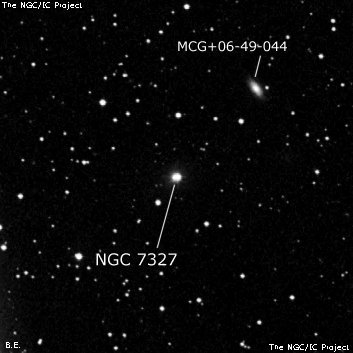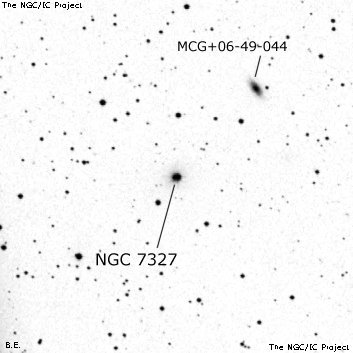NGC/IC Project Restoration Effort
(This is a very very beta version)
NGC7327


Basic Information
Location and Magnitude
Right Ascension: 22:37:24.6
Declination: +34:25:42
Constellation: PEG
Visual Magnitude: 12.2
Historic Information
Discoverer: Tempel
Year of discovery: 1882
Discovery aperture: 11.0
Observational
Summary description: eF, eS, np h 2172
Sub-type: *
Corwin's Notes
=====
NGC 7327, unfortunately, is one of those "....many novae merely alluded to in
(Tempel's) published notes." A rough translation by me of what Tempel has to
say about N7327 in his published article doesn't really help much, but here it
is: "Of my eight companions [to N7331], Lord Rosse has still not seen two;
one [N7338, which see] is located in the middle of the four brighter
companions following, closer to the two southern objects; while the eighth
[N7327] precedes the northern end of the spindle." That is it.
Tempel gives no accurate positions or offsets, so all we have are the numbers
published in the NGC to lead us to the area. There is nothing in the
immediate vicinity but stars. However, about 4 arcmin northwest is a compact
galaxy with a star superposed (I think the object is the one that RNGC
incorrectly chose for N7325, which see) that might have been within range of
Tempel's telescope. I've chosen it as a possibility for his object.
However, there are four stars scattered around the NGC position. The
brightest is 1.5 arcmin southwest, the faintest is 1.1 arcmin north-northeast,
and the intermediate stars are 0.9 arcmin southeast and 0.9 arcmin east-
northeast. One of these is taken to be N7327 in RC1, MCG, and RNGC. Given
that so many of Tempel's new "nebulae" in other fields (see, e.g. NGC 4322 and
NGC 4768/9) are stars or asterisms, it is actually more likely that one of
these stars is his object than the galaxy that I give in the table. But which
one? So, I put them all in the table with question marks everywhere.
Steve's Notes
=====
NGC 7327
17.5" (10/17/98): this number refers to one of the several nonexistent NGC entries in the NGC 7331 vicinity. A possible candidate suggested by Harold Corwin is a mag 13 star near the tip of the northern extension of NGC 7331. This single star appeared stellar, although it seems plausible that it might look slightly nebulous due to the faint background haze of the galaxy. Other fainter nearby stars may instead apply to NGC 7327.



